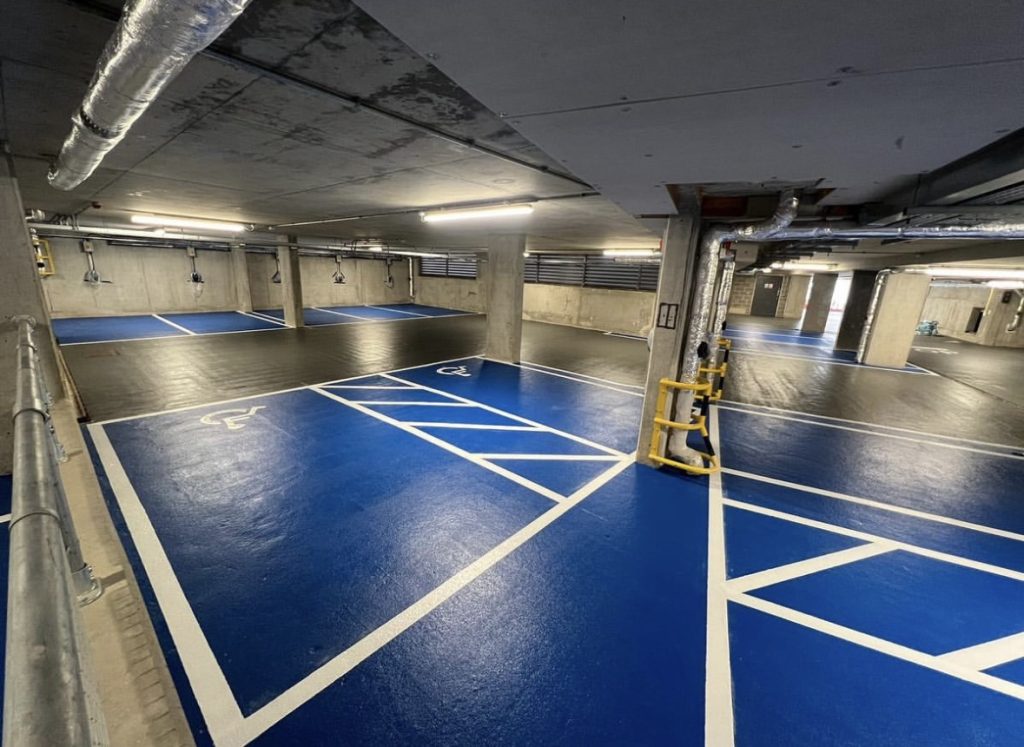What Do Road & Line Marking Colours Mean in the UK?

Clear, consistent colours help people navigate safely and keep sites compliant. This guide explains the most common road and line marking colours in the UK—how they’re typically used on public roads and how best practice applies to car parks and warehouses.
Note: Public highway markings are governed by UK regulations (e.g., TSRGD / Traffic Signs Manual). Private sites (car parks, warehouses) follow good practice and accessibility guidance rather than strict highway law. When in doubt, ask our team.
Quick Reference: Colour at a Glance.
-
White — General guidance and layout (lanes, bay outlines, walkways).
-
Yellow — Restrictions, caution areas, keep-clear hatchings.
-
Red — Red Routes (no stopping) and designated high-priority safety areas.
-
Blue — Commonly used for accessible bays (private car parks), paired with signage.
-
Green — Widely used for EV charging bays and approach areas.
-
Black — Used to mask/remove old markings for a clean, safe finish.
Public Roads vs. Private Sites (What’s Different?).
-
Public roads: Colours, shapes, and layouts must follow UK regulations to ensure national consistency.
-
Private sites (car parks/warehouses): Colour use is more flexible; aim for clarity, accessibility, and internal policy alignment. Pair with correct signage and symbols.
White Line Markings.
Typical uses:
-
Roads: Lane lines, centre lines, edge lines, stop/give-way lines.
-
Car parks: Standard bay outlines, arrows, pedestrian routes.
-
Warehouses: Walkways, boundaries, grid layouts.
Why it matters: High contrast in most conditions, excellent for general guidance and route definition.
Yellow Line Markings.
Typical uses:
-
Roads: Waiting restrictions (single/double yellow lines as signed), bus stops, school keep-clear.
-
Car parks: Loading bays, keep-clear zones, caution areas.
-
Warehouses: Hazard perimeters, exclusion zones, crossing approaches.
Why it matters: Communicates caution or restriction. Pair with signs for clarity.
Red Line Markings.
Typical uses:
-
Roads: Red Routes (e.g., in London and other cities); single/double red lines control stopping as signed.
-
Sites: Selected safety-critical areas where maximum visibility is required (used sparingly and with clear policy).
Why it matters: Strong visual deterrent for stopping/standing; reserve for high-priority control.
Blue Line Markings.
Typical uses (private land):
-
Accessible parking bays (backgrounds, borders, symbols) to support accessibility and wayfinding.
-
Note: On the public highway, accessibility is primarily conveyed by signs/road markings rather than blue surfacing. Use local authority guidance.
Why it matters: Immediate recognition for accessible facilities when paired with the correct wheelchair symbol and signage.
Green Line Markings.
Where you’ll see them:
-
EV charging bays and approaches: helps drivers identify charging zones quickly.
Note: Colour conventions for EV are increasingly standardised in practice, but designs can vary by site.
Black Masking.
Typical uses:
-
Overlays/black thermoplastic to cover redundant markings ahead of new layouts.
Why it matters: Reduces confusion and improves safety during reconfigurations or phased works.
Hatched Areas (Typically Yellow or White).
Used to keep clear of hazards, control turning, protect pedestrian space, or discourage parking/standing. In car parks and sites, use hatching to guard crossings, corners, gates, loading doors, and equipment zones.
Why Colour Choice Matters.
-
Safety & compliance: Clear, consistent colours reduce incidents and support regulatory obligations.
-
Accessibility: Colour contrast improves legibility for all users.
-
Professional appearance: A tidy, coherent scheme reflects well on your brand and operations.
Why Choose C&R.
As one of the UK’s leading specialists in line marking, surface preparation, coatings, and cleaning, C&R delivers expert advice, professional results, and long-lasting performance nationwide.
Over 30 Years’ Experience
Trusted nationwide by major brands and local authorities.
Fully Accredited & Insured
Working to UK safety and environmental standards.
Complete Start-to-Finish Service
From design and preparation to marking and aftercare.
Nationwide Coverage
Responsive teams operating across England, Scotland, and Wales.
